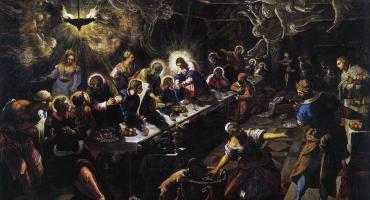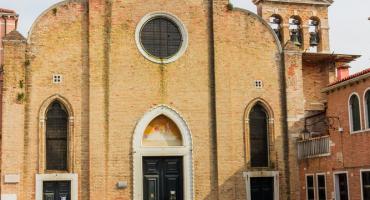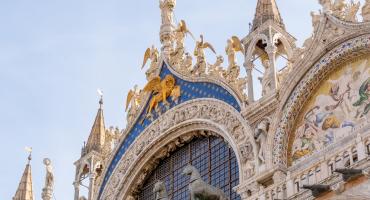Contribution of art from Veneto to history of universal art, particularly during the Renaissance, gets appreciated through this itinerary and a real cultural koinè of figurative arts is accomplished: local artists make use of capacity to capture the changing light that passes on and changes effect, by means of material, deaf in itself, unreflecting and opaque, through manipulation of materials like oil, resins and pigments which in one complete harmony managing to recreate the magic and live effect of natural light.
In the painting “Profane Love” by Titian it is possible to see transparent blue veins on the girl’s face (while in the Florentine paintings the portraits appear outlined with plastic effects that derived from various repertories amongst which also including the sculptural education of Michelangelo). In the School the story-line and the contour are characterised in a predominating way in paintings which live as fosterage of sculptures, while amongst painters from Veneto prevails the epidemic effect of material as regards to the source of light.
To the technique of “stress on tonality”, set running for the first time by Giorgione in the early 16th century, contribute a sort of harmonious concert in return of one element to another, like expressive means of the fusion of elements which are all inserted in the same coloured bath, the artist who compresses also synthesizes in the widest possible way placing himself diminutively and opposite to the idol of Michelangelo in the forms and definite contours.
Harmonium concept of colour in Venice finds its apotheosis in the last canvas by Titian’s Pietà (Accademia gallery) where each sign on the canvas has a profound impact on the observer’s feelings and therefore an early anticipation and intuition of abstract expressionism are sensed, where the colours allude and rely on a ghostly body inside the canvas, the colour explodes from the shapes and spills onto the eyes of the spectator outside the border of the canvas.
After the highest period of renaissance coinciding with experience of the divine painter Titian, where the colour generated shapes and pictorial contents, the baton passes to Tintoretto that decorates most Venetian churches. 17th century was a period of stagnation, a seventeenth-century darkness started with the forbidden interdict by Sarpi, sinking of great culture with landscapes by foreign painters, even if Rubens, Veleasquez, Morillo etc. got inspired by combination of light and colour of the School from Veneto, which will have its last moment of great splendour in 18th century.
It can be said that in 17th century the terrain gets harder and leaves itself to fallow for the last great period of 18th century with Tiepolo, the greatest European baroque painter and, on the same view, Tiepolo works in a wandering way, in fact, like artists in those days who were by now wanderers as Vivaldi, Goldoni, Canova, as Mozart himself, always at service of the European courts which paid better and from where their fame started, these men brought anyway their local chromosomes like promoters of their lands and cultures.
18th century was another great century for pictorial Venice despite the decadence and the end of Serenissima that had been announced for some time by few parties; even if the themes and the clients were less religious, the artists of the century of Enlightenment revived the tradition of 16th century: evasive elements in tones, panic vision of nature and its representation, the man (even if the feminine component is predominant), diving into landscape: these elements which are typical of local tradition get developed according to various genres of paintings amongst which the Arcadian landscape, the view, the caprice and still the historic and narrative paintings where the figure of Tiepolo emerges in full relief.
At the end of 18th century with the fall of the Republic and after a short neoclassical experience of Canova, the theme of nostalgia of memories that puts on twilight tones prevails in the artists’ souls of Venetian origin (Hayez). This concept gets really well presented in the film “Sense”, a sublime masterpiece by Luchino Visconti, where Venice is represented on verge of the abyss through a dramatical vision of feelings and in which love is nothing else but a crazy sacrifice to the beauty, especially in the masterly scene of kissing at dawn on the run after the last dramatic night of love in which a young Austrian officer responds to a trembling character of Virna Lisi “Don’t love me! Nobody has to love me…”. It’s a pictorial quotation of the famous kiss by Hayez in which the Milanese Visconti identifies a kind of nostalgic amarcord of the great pictorial tradition from Veneto revisited from a romantic point of view, and emphasis on colour both in the film and in the painting reveal it very well. (D'annunzio in The Fire, a vision of a burning Venice that eternally returns to life…)
Colouristic triumphs from the past are a kind of faraway illusion by now, while the local painters from the period of unification of Italy (Ciardi and Milesi) paid their attention for the first time to derelicts and less to Venetiatism (the famous picture by Nono “Refuge of Sinners” set in Chiogghia).
And while Futurists actually said “ Let’s kill Venice at the moonlight” like finishing a useless world that doesn’t need to exist any longer in order not to slow down the triumphing and annihilating modernity.
Venice, as a metaphor of beauty (from the aesthetic and academic conception of life) seen at this point as a restraint of functionality, of concern with efficiency and of industry. That futurist, a prelude to one Veneto which is paradigmatic from change of times: one land once synthesised from: sea, lagoon, city of art, close hills, mountains in the background; on the push of industrial development and Italian economic miracle in another perspective gets synthesized: from Marghera port with the sinking sunset and assumes a tragic aspect, and grotesque in comparison to the beauty of nature and artistic preciosities that has been added by the man for centuries.
{mospagebreak}
PLACES :
Six religious buildings (San Marco, San Zaccaria, S.Giovanni in Bragora, Frari, San Sebastian, Gesuati) and Accademia the temple of Venetian paintings from 14th to 18th century.
Concrete visualisation of materials takes place in a present-day artistic laboratory where it is possible to verify in reality the themes dealt with during the visits.
1° stage:
San Marco: from the origins of paintings from Veneto, from late-Gothic art to dialectics between light, colour and new techniques.
The origins and St Mark’s myth (frontal method) in making of mosaics and enamel.
Pala d’Oro (golden altar-piece) and St Mark’s treasures
Museum of St Marks’ work of art, Altar-piece by Paolo Veneziano: start of a local school
2° stage:
San Zaccaria: chapel San Tarasio, polyptychs by Giovanni d’Alemagna and Vivarini: gilded polyptych with tiles and saints, a local figure starts to take shape with a slight surrender of the incarnated (sensuality)
San Giovanni in Bragora: Vivarini (Alvise and Bartolomeo), Madonna with a dead child in her arms (left aisle) and Cima da Conegliano
Dialectics or contrast between a conception linked to drawings in comparison to the use of colour which will prevail with the Venetian masters (while the Tuscan painters preferred drawings)
3° stage:
Laboratory by art master Zanusso
Practical accomplishment of a stroke on paper and canvas, concrete experience of primary colours (red, yellow and blue according to the system of subtractive synthesis) and secondary colours (green, orange, purple); effect of complementarities (cutting out or tendency to grey of some colours for mixing) ; recognition of timbre (pure colour) and tone (colours which interpenetrate a/o are superimposed on each other), live glazing, body impasto, invention of oil paintings (in ancient way, that is the contents on natural and precious basis).
References to the paintings visited so far and to the Venetian landscape, and preparation for what will be seen the day after.
4° stage: (2° day)
Accademia: in front of the Storm by Giorgione, a vision will occur and manifesting tonalism, extreme and total, almost like a mirage, an explosion of senses up to the limits as regards to the period of those days. In the next door room S.Giovanni Battista by Titian shows that the pure colour understood like fancy cake, substance, is endowed with a strong sensual charge, like exuberance of matter and food for eyes. Here, it is possible to appreciate the fundamental theme of the difference between the landscape, the view and the caprice; three different genres that may be summed up: the view understood as a place reproduced with accuracy of the chosen place of the painting, the landscape is an emblem painting of natural realities combined with perspectives and categories of classical tradition (a utopia, mediate reality) and finally the caprice in 18th century arbitrary combination of different views a/o with landscapes where existing places are combined with the imaginary ones.
5° stage:
Frari: in Assumption of the Virgin by Titian on the altar we’ll see the extent of use of chromatic effects, pictorial magnificence and versatility, particularly the teachings of glazing by Pala Pesaro especially of mantle of the procurator, soft effects of the incarnated due to refraction of light between pictorial layers that lay one upon another in order to obtain the effect of light refraction.
After coming out of Frari, we continue towards Campo San Margherita and passing through the Church of Carmini and Fondamenta Briati, the Church of San Sebastian will be visited and, as an outstanding example of artistic synthesis and synergic crossing between three great arts (architecture, painting and sculpture) in addition to colour as a predominant element, a kind of competition-cooperation between materials and tools is materialised, the effects of a great brightness of colour are noticed, a sort of amplification and a solo in this concert where arts add up together in a higher result than single parts.
The Church of San Sebastian is lucky to have maintained its artworks intact for centuries, even today, as an outcome jointly wanted by the 16th century artists, a concrete example of harmony and synthesis of that era.
Architecture: Scarpagnino and Palladio
Sculpture: Sansovino
Painting: Paolo Veronese and Titian
To see at San Sebastian the sacristy with masterworks by young Veronese, everything only few centimetres from your eyes and still there.
Another example of this fusion of arts in a unique place and time is Villa Maser (superb synthesis of Palladio’s elements, Vittoria’s sculpture; Veronese’s frescos)
6° stage:
Church of Gesuati, where Tiepolo, Ricci and Piazzetta will be admired.
The Church of Santa Maria della Fava, unfortunately often closed, should be like San Sebastian in the beginning of 18th century with harmonious synthesis of painting, sculpture and architecture according to this short circuit of arts.
Bibliography:
References to a serious bibliographic background of that period require a very long list. From Lorenzetti and Molmenti (Venetian life), Cicogna (Bibliography), Tassini (curiosities), Romanin, Cessi (history), Art from Veneto by ELECTA, Boschini (Paper from pictorial sailor), Redolfi (art)
Suggested reading is Aretino’s letter written to Rialto in August during Titian’s absence from Venice in 1537.
From the same letter it is clear that literature depends on painting, in fact, Aretino simulates the pictorial effect with his pen invoking Titian, while usually the opposite occurred, from here we can see live Titian’s greatness and fame recognised by his contemporary artists and literary men. A constant of the Renaissance of court, that mature one from 1510 to Council of Trent where painting prevails between arts (a bit like Da Ponte who had difficulty in writing for Mozart if music concealed the meaning of the artwork or in 18th century Metastasio wrote works where performers worked hard to follow).
Marco Zanusso (Tel. 3288749196 – 041 5283234)
Painter and Art Historian, as well as an expert of instruments in accomplishing of works.
If you wish, he will accompany you in this itinerary and will let you experiment in his artistic laboratory a concrete experience of making art through his expressive material, the colour, following and “running after” instruments and methods of the extraordinary ancient local tradition recuperated through a scientific and philological operation.



